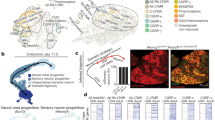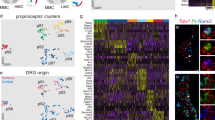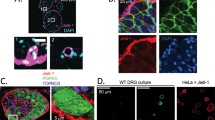Abstract
We used conditional knockout strategies in mice to determine the developmental events and gene expression program regulated by the LIM-homeodomain factor Islet1 in developing sensory neurons. Early development of the trigeminal and dorsal root ganglia was grossly normal in the absence of Islet1. From E12.5 onward, however, Isl1 mutant embryos showed a loss of the nociceptive markers TrkA and Runx1 and a near absence of cutaneous innervation. Proprioceptive neurons characterized by the expression of TrkC, Runx3 and Etv1 were relatively spared. Microarray analysis of Isl1 mutant ganglia revealed prolonged expression of developmental regulators that are normally restricted to early sensory neurogenesis and ectopic expression of transcription factors that are normally found in the CNS, but not in sensory ganglia. Later excision of Isl1 did not reactivate early genes, but resulted in decreased expression of transcripts related to specific sensory functions. Together these results establish a central role for Islet1 in the transition from sensory neurogenesis to subtype specification.
This is a preview of subscription content, access via your institution
Access options
Subscribe to this journal
Receive 12 print issues and online access
$209.00 per year
only $17.42 per issue
Buy this article
- Purchase on Springer Link
- Instant access to full article PDF
Prices may be subject to local taxes which are calculated during checkout







Similar content being viewed by others
References
Ma, Q., Fode, C., Guillemot, F. & Anderson, D.J. Neurogenin1 and neurogenin2 control two distinct waves of neurogenesis in developing dorsal root ganglia. Genes Dev. 13, 1717–1728 (1999).
Fode, C. et al. The bHLH protein Neurogenin2 is a determination factor for epibranchial placode–derived sensory neurons. Neuron 20, 483–494 (1998).
Anderson, D.J. Lineages and transcription factors in the specification of vertebrate primary sensory neurons. Curr. Opin. Neurobiol. 9, 517–524 (1999).
Eng, S.R. et al. Defects in sensory axon growth precede neuronal death in Brn3a-deficient mice. J. Neurosci. 21, 541–549 (2001).
Eng, S.R., Lanier, J., Fedtsova, N. & Turner, E.E. Coordinated regulation of gene expression by Brn3a in developing sensory ganglia. Development 131, 3859–3870 (2004).
Eng, S.R., Dykes, I.M., Lanier, J., Fedtsova, N. & Turner, E.E. POU-domain factor Brn3a regulates both distinct and common programs of gene expression in the spinal and trigeminal sensory ganglia. Neural Develop. 2, 3 (2007).
Pfaff, S.L., Mendelsohn, M., Stewart, C.L., Edlund, T. & Jessell, T.M. Requirement for LIM homeobox gene Isl1 in motor neuron generation reveals a motor neuron–dependent step in interneuron differentiation. Cell 84, 309–320 (1996).
Cai, C.L. et al. Isl1 identifies a cardiac progenitor population that proliferates prior to differentiation and contributes a majority of cells to the heart. Dev. Cell 5, 877–889 (2003).
Moretti, A. et al. Multipotent embryonic Isl1+ progenitor cells lead to cardiac, smooth muscle and endothelial cell diversification. Cell 127, 1151–1165 (2006).
Sun, Y. et al. Islet 1 is expressed in distinct cardiovascular lineages, including pacemaker and coronary vascular cells. Dev. Biol. 304, 286–296 (2007).
Woolf, C.J. & Ma, Q. Nociceptors—noxious stimulus detectors. Neuron 55, 353–364 (2007).
Marmigere, F. & Ernfors, P. Specification and connectivity of neuronal subtypes in the sensory lineage. Nat. Rev. Neurosci. 8, 114–127 (2007).
Chen, C-L. et al. Runx1 determines nociceptive sensory neuron phenotype and is required for thermal and neuropathic pain. Neuron 49, 365–377 (2006).
Yoshikawa, M. et al. Runx1 selectively regulates cell fate specification and axonal projections of dorsal root ganglion neurons. Dev. Biol. 303, 663–674 (2007).
Kramer, I. et al. A role for Runx transcription factor signaling in dorsal root ganglion sensory neuron diversification. Neuron 49, 379–393 (2006).
Levanon, D. et al. The Runx3 transcription factor regulates development and survival of TrkC dorsal root ganglia neurons. EMBO J. 21, 3454–3463 (2002).
Inoue, K. et al. Runx3 controls the axonal projection of proprioceptive dorsal root ganglion neurons. Nat. Neurosci. 5, 946–954 (2002).
Quina, L.A. et al. Brn3a-expressing retinal ganglion cells project specifically to thalamocortical and collicular visual pathways. J. Neurosci. 25, 11595–11604 (2005).
Lawson, S.N. & Biscoe, T.J. Development of mouse dorsal root ganglia: an autoradiographic and quantitative study. J. Neurocytol. 8, 265–274 (1979).
Farinas, I., Wilkinson, G.A., Backus, C., Reichardt, L.F. & Patapoutian, A. Characterization of neurotrophin and Trk receptor functions in developing sensory ganglia: direct NT-3 activation of TrkB neurons in vivo. Neuron 21, 325–334 (1998).
Fundin, B.T. et al. Differential dependency of cutaneous mechanoreceptors on neurotrophins, trk receptors, and P75 LNGFR. Dev. Biol. 190, 94–116 (1997).
Luo, W. et al. A hierarchical NGF signaling cascade controls Ret-dependent and Ret-independent events during development of nonpeptidergic DRG neurons. Neuron 54, 739–754 (2007).
Vellani, V. et al. Sensitization of transient receptor potential vanilloid 1 by the prokineticin receptor agonist Bv8. J. Neurosci. 26, 5109–5116 (2006).
Gierl, M.S., Karoulias, N., Wende, H., Strehle, M. & Birchmeier, C. The zinc-finger factor Insm1 (IA-1) is essential for the development of pancreatic beta cells and intestinal endocrine cells. Genes Dev. 20, 2465–2478 (2006).
Laugwitz, K.L. et al. Postnatal Isl1+ cardioblasts enter fully differentiated cardiomyocyte lineages. Nature 433, 647–653 (2005).
Fedtsova, N.G. & Turner, E.E. Brn-3.0 Expression identifies early post-mitotic CNS neurons and sensory neural precursors. Mech. Dev. 53, 291–304 (1995).
Lanier, J., Quina, L.A., Eng, S.R., Cox, E. & Turner, E.E. Brn3a target gene recognition in embryonic sensory neurons. Dev. Biol. 302, 703–716 (2007).
Breslin, M.B., Zhu, M. & Lan, M.S. NeuroD1/E47 regulates the E-box element of a novel zinc finger transcription factor, IA-1, in developing nervous system. J. Biol. Chem. 278, 38991–38997 (2003).
Marmigere, F. et al. The Runx1/AML1 transcription factor selectively regulates development and survival of TrkA nociceptive sensory neurons. Nat. Neurosci. 9, 180–187 (2006).
Huang, E.J. et al. POU domain factor Brn-3a controls the differentiation and survival of trigeminal neurons by regulating Trk receptor expression. Development 126, 2869–2882 (1999).
McEvilly, R.J. et al. Requirement for Brn-3.0 in differentiation and survival of sensory and motor neurons. Nature 384, 574–577 (1996).
Ichikawa, H., Mo, Z., Xiang, M. & Sugimoto, T. Effect of Brn-3a deficiency on parvalbumin-immunoreactive primary sensory neurons in the dorsal root ganglion. Brain Res. Dev. Brain Res. 150, 41–45 (2004).
Paratore, C., Brugnoli, G., Lee, H.Y., Suter, U. & Sommer, L. The role of the Ets domain transcription factor Erm in modulating differentiation of neural crest stem cells. Dev. Biol. 250, 168–180 (2002).
Chotteau-Lelievre, A., Desbiens, X., Pelczar, H., Defossez, P.A. & de Launoit, Y. Differential expression patterns of the PEA3 group transcription factors through murine embryonic development. Oncogene 15, 937–952 (1997).
Hippenmeyer, S. et al. A developmental switch in the response of DRG neurons to ETS transcription factor signaling. PLoS Biol. 3, e159 (2005).
Lei, L., Zhou, J., Lin, L. & Parada, L.F. Brn3a and Klf7 cooperate to control TrkA expression in sensory neurons. Dev. Biol. 300, 758–769 (2006).
Chen, Z.F. et al. The paired homeodomain protein DRG11 is required for the projection of cutaneous sensory afferent fibers to the dorsal spinal cord. Neuron 31, 59–73 (2001).
Rebelo, S., Chen, Z.F., Anderson, D.J. & Lima, D. Involvement of DRG11 in the development of the primary afferent nociceptive system. Mol. Cell. Neurosci. 33, 236–246 (2006).
Kania, A., Johnson, R.L. & Jessell, T.M. Coordinate roles for LIM homeobox genes in directing the dorsoventral trajectory of motor axons in the vertebrate limb. Cell 102, 161–173 (2000).
Kania, A. & Jessell, T.M. Topographic motor projections in the limb imposed by LIM homeodomain protein regulation of ephrin-A:EphA interactions. Neuron 38, 581–596 (2003).
Mizuhara, E., Nakatani, T., Minaki, Y., Sakamoto, Y. & Ono, Y. Corl1, a novel neuronal lineage-specific transcriptional co-repressor for the homeodomain transcription factor Lbx1. J. Biol. Chem. 280, 3645–3655 (2005).
Gross, M.K., Dottori, M. & Goulding, M. Lbx1 specifies somatosensory association interneurons in the dorsal spinal cord. Neuron 34, 535–549 (2002).
Muller, T. et al. The homeodomain factor lbx1 distinguishes two major programs of neuronal differentiation in the dorsal spinal cord. Neuron 34, 551–562 (2002).
Zhou, Q. & Anderson, D.J. The bHLH transcription factors OLIG2 and OLIG1 couple neuronal and glial subtype specification. Cell 109, 61–73 (2002).
Novitch, B.G., Chen, A.I. & Jessell, T.M. Coordinate regulation of motor neuron subtype identity and pan-neuronal properties by the bHLH repressor Olig2. Neuron 31, 773–789 (2001).
Lee, S.K., Lee, B., Ruiz, E.C. & Pfaff, S.L. Olig2 and Ngn2 function in opposition to modulate gene expression in motor neuron progenitor cells. Genes Dev. 19, 282–294 (2005).
Reik, W. Stability and flexibility of epigenetic gene regulation in mammalian development. Nature 447, 425–432 (2007).
Ahlgren, U., Pfaff, S.L., Jessell, T.M., Edlund, T. & Edlund, H. Independent requirement for ISL1 in formation of pancreatic mesenchyme and islet cells. Nature 385, 257–260 (1997).
Naya, F.J. et al. Diabetes, defective pancreatic morphogenesis and abnormal enteroendocrine differentiation in BETA2/neuroD-deficient mice. Genes Dev. 11, 2323–2334 (1997).
Liu, W.D., Wang, H.W., Muguira, M., Breslin, M.B. & Lan, M.S. INSM1 functions as a transcriptional repressor of the neuroD/beta2 gene through the recruitment of cyclin D1 and histone deacetylases. Biochem. J. 397, 169–177 (2006).
Acknowledgements
We would like to thank T. Jessell, S. Arber, L. Reichardt, M. Wegner, D. Lima and S. Pfaff for antibodies, and Q. Ma and J. Johnson for in situ hybridization probes (Methods). We would also like to thank N. Webster and L. Shireen of the University of California San Diego/Veterans Affairs Microarray Core for assistance with microarray technology, and G.C. Parico and A. Jackson for technical assistance. Mouse monoclonal antibodies were obtained from the Developmental Studies Hybridoma Bank, maintained under contract NO1-HD23144 from the US National Institute of Child Health and Human Development. This work was supported in part by Department of Veterans Affairs MERIT funding and US National Institutes of Health awards HD33442 and MH065496 to E.E.T. and HL074066 to S.M.E. E.E.T. is a National Alliance for Research on Schizophrenia and Depression Investigator.
Author information
Authors and Affiliations
Corresponding authors
Supplementary information
Supplementary Text and Figures
Supplementary Figures 1–6, Supplementary Tables 1–3 and Supplementary Methods (PDF 1031 kb)
Rights and permissions
About this article
Cite this article
Sun, Y., Dykes, I., Liang, X. et al. A central role for Islet1 in sensory neuron development linking sensory and spinal gene regulatory programs. Nat Neurosci 11, 1283–1293 (2008). https://doi.org/10.1038/nn.2209
Received:
Accepted:
Published:
Issue Date:
DOI: https://doi.org/10.1038/nn.2209
This article is cited by
-
ISL1 controls pancreatic alpha cell fate and beta cell maturation
Cell & Bioscience (2023)
-
Satellite Glial Cells Give Rise to Nociceptive Sensory Neurons
Stem Cell Reviews and Reports (2021)
-
Dual SMAD inhibition and Wnt inhibition enable efficient and reproducible differentiations of induced pluripotent stem cells into retinal ganglion cells
Scientific Reports (2020)
-
Statistical analysis of spatial expression patterns for spatially resolved transcriptomic studies
Nature Methods (2020)
-
Single cell RNA sequencing identifies early diversity of sensory neurons forming via bi-potential intermediates
Nature Communications (2020)



